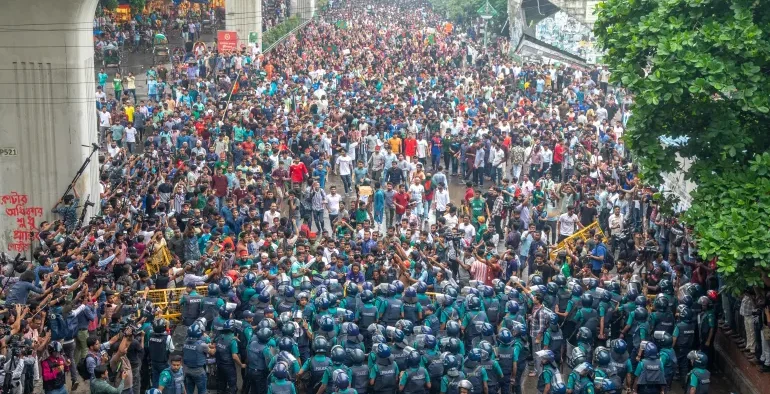What to know about the deadly student protests in Bangladesh

Dozens of people have died since the violence erupted, and hundreds more have been injured.
KEY POINTS
- Two weeks of student protests in Bangladesh have turned violent with hundreds of students attacked.
- Students are demanding the government scrap an affirmative action policy for prestigious civil service jobs.
- The protests began on 1 July, with university students blocking major roads and railway lines around the country.
A high-security alert has been issued in Bangladesh after student protests against a government job policy turned deadly.
At least 39 people have died and hundreds more have been injured amid the escalating violence.
The government ordered the indefinite closure of Bangladesh’s schools and universities on Tuesday in an attempt to quell the unrest, and shut down the mobile internet network nationwide on Thursday to “ensure the security of citizens”.
Why are the students protesting?
The students are demanding the government scrap its preferential hiring rules for prestigious civil service jobs.
Bangladesh has more than 1.9 million civil servant posts, according to a 2022 report by the country’s public administration ministry.

The most contentious aspect of this quota system is the reservation of 30 per cent of posts for children of freedom fighters who fought in the country’s 1971 liberation war against Pakistan.
The current rules were introduced in 1972 by independence leader Sheikh Mujibur Rahman, father of current Prime Minister Sheikh Hasina.
Earlier protests by students in 2018 prompted Hasina’s administration to cut down the quota scheme.
Why do students oppose the quota rules?
Bangladesh was one of the world’s poorest countries when it gained independence in 1971 and suffered a devastating famine three years later.
Its economy has grown dramatically in the decades since, thanks largely to a thriving
and accounts for around $50 billion in yearly exports.
But the country still struggles to provide adequate employment opportunities for its burgeoning population of about 170 million people.
Economists say the jobs crisis is especially acute for millions of university graduates.
Civil service posts offer a chance at stable lifetime employment, but students say the quota system is abused to stuff government posts with loyalists of Hasina’s ruling Awami League party.
How have the protests unfolded?
Protests began on 1 July with university students blocking major roads and railway lines in big cities around the country to draw attention to their demands.
They have continued nearly every day since, with high school students also joining the rallies, despite Bangladesh’s top court suspending the quota system on 10 July for one month and urging demonstrators to return to class.

Monday saw the start of fierce clashes between anti-quota demonstrators and the student wing of the Awami League, with more than 400 people injured across two Dhaka universities.
How has the government responded?
The prime minister has condemned the protests as pointless, saying this month that the students “are wasting their time” given that the rules have already been suspended.
But with no sign of the demonstrations abating, her government has escalated its efforts to quell the campaign.
On Tuesday, the education ministry ordered all schools, universities and Islamic seminaries nationwide to shut down until further notice, and deployed the paramilitary Border Guard Bangladesh force to keep order in several cities.
Police that night raided the headquarters of the Bangladesh Nationalist Party, arresting seven members of its student wing and claiming they had found a cache of Molotov cocktails and other weapons.
SBS











